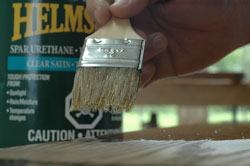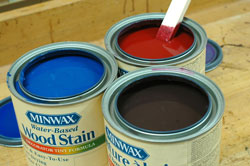 Canada is more than six months into a two-year phase-out period for many solvent-based wood finishes, and the changes are showing up on store shelves. You may have noticed gallon cans of your favourite finish disappearing, replaced by something different. The main issue is a group of substances called volatile organic compounds (VOCs). Government-led changes to reduce VOCs in the atmosphere are behind the shift, and it affects the products you can buy and how you use them.
Canada is more than six months into a two-year phase-out period for many solvent-based wood finishes, and the changes are showing up on store shelves. You may have noticed gallon cans of your favourite finish disappearing, replaced by something different. The main issue is a group of substances called volatile organic compounds (VOCs). Government-led changes to reduce VOCs in the atmosphere are behind the shift, and it affects the products you can buy and how you use them.
Volatile Organic Compound Regulation
The issue centres around the solvents that make many traditional urethanes, varnishes, stains and paints dry, and they’re more harmful than we used to think, though not in obvious ways. We know now that small concentrations of VOCs trigger widespread negative reactions in the atmosphere. VOCs also cause measurably lower indoor air quality in homes and offices. Whether you think these issues are worth worrying about doesn’t change the fact that more and more store shelf space is devoted to water-based finishes, especially in the one gallon format.
Water-based urethane first hit store shelves in the mid-1980s, and though these products dry quickly, clear, and offer exceptional safety and low odour, it’s not always easy to get good results with them. Quick drying times can lead to more visible brush strokes and air bubbles, though this is not inevitable. To see how I get the most from water based stains and sealers in my own shop, check out my video tutorial…it’s one of my most popular videos.
Water-Based Finishes for Wood
 While water-based finishes have been around for a while, there is something also brand new on the market that’s designed to meet tightening VOC regulations. As a replacement for the phased out solvent-based products in one gallon cans, some manufacturers have developed what they call water-based, oil-modified urethanes. These products have substantially longer drying times than water-based, and while this does extend the finishing process, it also makes it easier to achieve smooth results. Longer drying periods typically allows more time for a finish to flow out and form a smooth surface film, especially when applied with a brush or foam pad.
While water-based finishes have been around for a while, there is something also brand new on the market that’s designed to meet tightening VOC regulations. As a replacement for the phased out solvent-based products in one gallon cans, some manufacturers have developed what they call water-based, oil-modified urethanes. These products have substantially longer drying times than water-based, and while this does extend the finishing process, it also makes it easier to achieve smooth results. Longer drying periods typically allows more time for a finish to flow out and form a smooth surface film, especially when applied with a brush or foam pad.
Price is another thing that’s changing. The new VOC-compliant finishes cost roughly 20% more than the products they replace, at least for now. On the plus side, low-VOC products can be applied over any existing finishes – either solvent- or water-based – as long as the underlying surface is fully dry. If you really don’t want to give up your old VOC-rich finish, you can probably still find it in litre-sized cans. Industry insiders tell me that it’s only the larger containers that are being targeted because they contribute the most VOC emissions.
Finishing Woodwork
Regardless of the kind of finish you apply, nothing will create a smooth finish on wood without two kinds of sanding. Besides starting with a smooth wood surface, you also need to sand each coat of finish after it’s dried, and before the next coat goes on. Wood fibers expand and stand upright on a microscopic level when they soak up liquids, creating a very rough surface on wood that used to feel smooth. Sand the surface with 240-grit sand paper after the finish dries completely, vacuum the dust off, then apply a second coat and repeat. Leave the third coat alone as your final finish, and it will be quite smooth.
Gallon-size cans of my favourite urethane are on the chopping block, but I’m okay with that. Change is one of the only constant factors in the world these days, and we have to expect that if we also want to see the bigger picture get better.